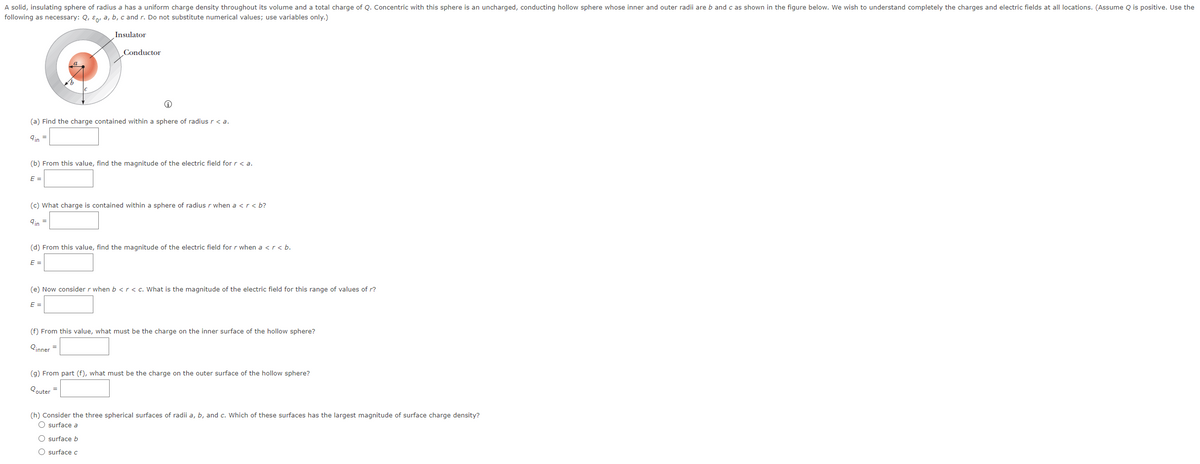A solid, insulating sphere of radius a has a uniform charge density throughout its volume and a total charge of Q. Concentric with this sphere is an uncharged, conducting hollow sphere whose inner and outer radil are b and c as shown in the figure below. We wish to understand completely the charges and electric fields at all locations. (Assume Q is positive. Use the following necessary: a, c and r. Do not use variables only.) b, Insulator Conductor Ⓒ (a) Find the charge contained within a sphere of radius rca (b) From this value, find the magnitude of the electric field for r
A solid, insulating sphere of radius a has a uniform charge density throughout its volume and a total charge of Q. Concentric with this sphere is an uncharged, conducting hollow sphere whose inner and outer radil are b and c as shown in the figure below. We wish to understand completely the charges and electric fields at all locations. (Assume Q is positive. Use the following necessary: a, c and r. Do not use variables only.) b, Insulator Conductor Ⓒ (a) Find the charge contained within a sphere of radius rca (b) From this value, find the magnitude of the electric field for r
Chapter6: Gauss's Law
Section: Chapter Questions
Problem 86AP: Two non-conducting spheres of radii R1 and R2 are uniformly charged with charge densities p1 and p2...
Related questions
Question

Transcribed Image Text:A solid, insulating sphere of radius a has a uniform charge density throughout its volume and a total charge of Q. Concentric with this sphere is an uncharged, conducting hollow sphere whose inner and outer radii are b and c as shown in the figure below. We wish to understand completely the charges and electric fields at all locations. (Assume Q is positive. Use the
following as necessary: Q, &, a, b, c and r. Do not substitute numerical values; use variables only.)
Insulator
Ⓡ
(a) Find the charge contained within a sphere of radius r < a.
9in
E =
D
=
(b) From this value, find the magnitude of the electric field for r < a.
Conductor
E =
(c) What charge is contained within a sphere of radius r when a <r<b?
9in
(d) From this value, find the magnitude of the electric field for r when a < r < b.
E =
(e) Now consider r when b <r < c. What is the magnitude of the electric field for this range of values of r?
(f) From this value, what must be the charge on the inner surface of the hollow sphere?
Qinner =
(g) From part (f), what must be the charge on the outer surface of the hollow sphere?
Qouter =
(h) Consider the three spherical surfaces of radii a, b, and c. Which of these surfaces has the largest magnitude of surface charge density?
O surface a
O surface b
O surface c
Expert Solution
This question has been solved!
Explore an expertly crafted, step-by-step solution for a thorough understanding of key concepts.
This is a popular solution!
Trending now
This is a popular solution!
Step by step
Solved in 5 steps

Knowledge Booster
Learn more about
Need a deep-dive on the concept behind this application? Look no further. Learn more about this topic, physics and related others by exploring similar questions and additional content below.Recommended textbooks for you


Physics for Scientists and Engineers: Foundations…
Physics
ISBN:
9781133939146
Author:
Katz, Debora M.
Publisher:
Cengage Learning


Physics for Scientists and Engineers: Foundations…
Physics
ISBN:
9781133939146
Author:
Katz, Debora M.
Publisher:
Cengage Learning